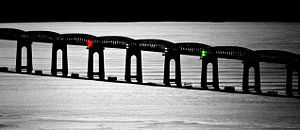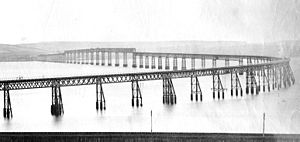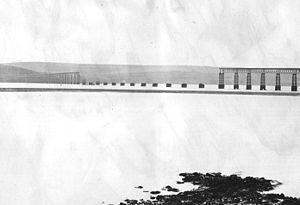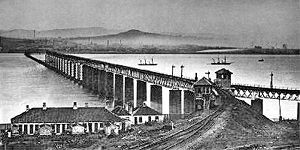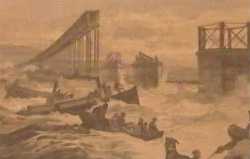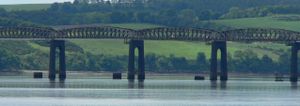Tay Rail Bridge
2008/9 Schools Wikipedia Selection. Related subjects: Architecture; Railway transport
| Tay Rail Bridge | |
|---|---|
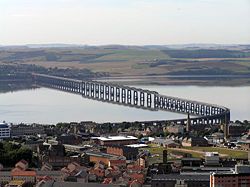 Tay Bridge at Dundee, Scotland from the Dundee Law |
|
| Carries | Rail traffic |
| Crosses | Firth of Tay |
| Locale | Dundee to Wormit |
| Total length | 3,264 metres (10,710 ft) |
| Beginning date of construction | July 22, 1871 (1st) July 6, 1883 (2nd) |
| Completion date | early 1878 (1st) 1887 (2nd) |
| Opening date | June 1, 1878 (1st) July 13, 1887 (2nd) |
| Destruction date | December 28, 1879 (1st) |
| Coordinates | |
The Tay Bridge (sometimes unofficially the Tay Rail Bridge) is a railway bridge approximately two and a quarter miles (three and a half kilometres) long that spans the Firth of Tay in Scotland, between the city of Dundee and the suburb of Wormit in Fife ( grid reference NO391277).
As with the Forth Bridge, the Tay Bridge has also been called the Tay Rail Bridge since the construction of a road bridge over the firth, the Tay Road Bridge. The rail bridge replaced an early train ferry.
The first Tay Bridge
The original Tay Bridge was constructed in the 19th century. It was designed by noted railway engineer Thomas Bouch, who received a knighthood following the bridge's completion. It was a lattice-grid design, combining cast and wrought iron. The design was well known, having been used first by Kennard in the Crumlin Viaduct in South Wales in 1858, following the innovative use of cast iron in The Crystal Palace. However, the Crystal Palace was not as heavily loaded as a railway bridge, such as the Dee bridge which collapsed in 1847 due to poor use of cast-iron girders. Later, Gustave Eiffel used a similar design to create several large viaducts in the Massif Central (1867).
Proposals for constructing a bridge across the River Tay date back to at least 1854. The North British Railway (Tay Bridge) Act received the Royal Assent on July 15, 1870 and the foundation stone was laid on July 22, 1871. As the bridge extended out into the river, it shortly became clear that the original survey of the estuary had not been competent. The bedrock, at a shallow depth near the banks, was found to descend deeper and deeper, until it was too deep to act as a foundation for the bridge piers. Bouch had to redesign the piers, and to set them very deep in the estuary bed to compensate for having no support underneath. He also reduced the number of piers by making the spans of the superstructure girders much longer than before. This made them greater than the maximum length without taking into account wind loadings.
The first engine crossed the bridge on September 22, 1877, and upon its completion in early 1878 the Tay Bridge was among the longest in the world. The bridge was opened on June 1, 1878.
While visiting the city, Ulysses S. Grant commented that it was "a big bridge for a small city".
The Tay Bridge Disaster
During a violent storm on the evening of 28 December 1879, the centre section of the bridge, known as the "High Girders", collapsed, taking with it a train that was running on its single track. 75 lives were lost, including that of Sir Thomas's son-in-law. The total number was only established by a meticulous examination of ticket sales, some from as far away as King's Cross. Forty-six of the sixty known victims were found, with two bodies not being recovered until February 1880.A common 19th century urban myth in Dundee was that Karl Marx would have been a passenger on the fatal train of 1879 had illness not prevented him from travelling.
Investigators quickly determined many faults in design, materials, and processes that had contributed to the failure. No allowance for wind load had been made by Bouch: he had been advised that this was unnecessary for girders shorter than 200ft, and had not followed this up for his new design with longer girders. The section in the middle of the bridge, where the rail ran inside high girders (through trusses), rather than on top of lower ones (deck trusses), to allow a sea lane below high enough for the masts of ships, was potentially top heavy and very vulnerable to high winds. Neither Bouch nor the contractor appeared to have regularly visited the on-site foundry where iron from the previous half-built bridge was recycled. The cylindrical cast iron columns supporting the 13 longest spans of the bridge, each 245 ft (75 m) long, were of poor quality. Many had been cast horizontally, with the result that the walls were not of even thickness, and there was some evidence that imperfect castings were disguised from the (very inadequate) quality control inspections. In particular, many of the lugs used as attachment points for the wrought iron bracing bars had been "burnt on" rather than cast with the columns. The lugs were tested for the Inquiry by David Kirkaldy and proved to break at only 20 tons rather than the expected load of 60 tons. It is believed that, during the storm, these lugs failed and destabilised the entire centre part of the bridge.
Official enquiry
The official enquiry was chaired by Henry Cadogan Rothery, Commissioner of Wrecks, supported by Colonel Yolland (Inspector of Railways) and civil engineer William Henry Barlow. They concluded that the bridge was "badly designed, badly built and badly maintained, and that its downfall was due to inherent defects in the structure, which must sooner or later have brought it down".
There was clear evidence that the central structure had been deteriorating for months before the final accident. The maintenance inspector, Henry Noble, had heard the joints of the wrought-iron tie-bars "chattering" a few months after the bridge opened in June 1878, a sound indicating that the joints had loosened. This made many of the tie-bars useless for bracing the cast-iron piers. Noble did not attempt to re-tighten the joints, but hammered shims of iron between them in an attempt to stop the rattling.
The problem continued until the collapse of the High Girders. It indicated that the centre section was unstable to lateral movement, something observed by painters working on the bridge in the summer of 1879. Passengers on north-bound trains complained about the strange motion of the carriages, but this was, apparently, ignored by the bridge's owners, the North British Railway. The Lord Provost of Dundee had reportedly timed trains on the bridge, and found they were travelling at about 40 mph, well in excess of the official limit of 25 mph.
The enquiry destroyed Bouch's professional reputation: "For these defects both in the design, the construction and the maintenance, Sir Thomas Bouch is, in our opinion, mainly to blame. For the faults of design he is entirely responsible". The Board of Trade, concerned about Bouch's design for the planned Forth Rail Bridge on the same railway line, imposed a specification of 56 pounds force per square foot (2.7 kPa). The contract for the new Forth Bridge was awarded to William Arrol & Co. using designs by Benjamin Baker and John Fowler. Bouch died within a year of the disaster.
Only the locomotive (NBR 224) survived the disaster, being salvaged from the river and repaired at Cowlairs. It remained in service until 1919, acquiring the nickname of "The Diver"; many superstitious drivers were reluctant to take it over the newly rebuilt bridge.
Works of literature about the disaster
The Victorian poet William Topaz McGonagall commemorated this event in his poem The Tay Bridge Disaster. Likewise, German poet Theodor Fontane, shocked by the news, wrote his poem Die Brück' am Tay (with obvious allusions to William Shakespeare and Friedrich von Schiller). It was published only ten days after the tragedy happened. Hatter's Castle, the 1931 novel of Scottish author A. J. Cronin, includes a scene involving the Tay Bridge Disaster, and the 1942 filmed version of the book dramatically recreates the bridge's catastrophic collapse. The bridge collapse figures prominently in Barbara Vine (Ruth Rendell's) 2002 novel " The Blood Doctor". Scottish author Sorche nic Leodhas (collector/reteller of Scottish fairy tales and ghost stories) wrote a story "The Tay Bridge Train" (told as a true story before she wrote it down) (many people told stories to her father), about a man who survives because he is warned (by the ghost of his best friend) not to take the Tay Bridge train.
A second bridge
A new double-track bridge was designed by William Henry Barlow and built by William Arrol & Co. 60 ft (18 m) slightly upstream of, and parallel to, the original bridge. The bridge proposal was formally incorporated in July 1881 and the foundation stone laid on July 6, 1883. Construction involved 25,000 tons of iron and steel, 70,000 tons of concrete, ten million bricks (weighing 37,500 tons) and three million rivets. Fourteen men lost their lives during its construction, mostly due to drowning.
The second bridge opened on 13 July 1887 and remains in use. In 2003, a £20.85 million strengthening and refurbishment project on the bridge won the British Construction Industry Civil Engineering Award, in consideration of the staggering scale and logistics involved. More than 1,000 tonnes of bird droppings were scraped off the ironwork lattice of the bridge using hand tools, and bagged into 25 kg sacks. Hundreds of thousands of rivets were removed and replaced, all work being done in very exposed conditions, high over a firth with fast-running tides.
The stumps of the original bridge piers are still visible above the surface of the Tay even at high tide.
"Tay Bridge" was also the codename for the funeral plans for Queen Elizabeth, The Queen Mother.
